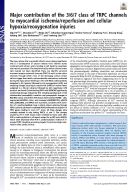Por favor, use este identificador para citar o enlazar este ítem:
https://repositorio.uca.edu.ar/handle/123456789/8529| Título: | Major contribution of the 3/6/7 class of TRPC channels to myocardial ischemia/reperfusion and cellular hypoxia/reoxygenation injuries | Autor: | He, Xiju Li, Shoutian Liu, Benju Susperreguy, Sebastián Formoso, Karina Yao, Jinghong Kang, Jinsong Anbing, Shi Birnbaumer, Lutz Liao, Yanhong |
Palabras clave: | INFARTO DEL MIOCARDIO; CALCIO; APOPTOSIS; MUERTE CELULAR | Fecha de publicación: | 2017 | Editorial: | National Academy of Sciences | Cita: | Xiju, H., et. al. Major contribution of the 3/6/7 class of TRPC channels to myocardial ischemia/reperfusion and cellular hypoxia/reoxygenation injuries [en línea]. Proceedings of the National Academy of Sciences. 2017, 114 (23). doi:10.1073/pnas.1621384114. Disponible en: https://repositorio.uca.edu.ar/handle/123456789/8529 | Resumen: | Abstract: The injury phase after myocardial infarcts occurs during reperfusion and is a consequence of calcium release from internal stores combined with calcium entry, leading to cell death by apoptopic and necrotic processes. The mechanism(s) by which calcium enters cells has(ve) not been identified. Here, we identify canonical transient receptor potential channels (TRPC) 3 and 6 as the cation channels through which most of the damaging calcium enters cells to trigger their death, and we describe mechanisms activated during the injury phase. Working in vitro with H9c2 cardiomyoblasts subjected to 9-h hypoxia followed by 6-h reoxygenation (H/R), and analyzing changes occurring in areas-at-risk (AARs) of murine hearts subjected to a 30-min ischemia followed by 24-h reperfusion (I/R) protocol, we found: (i) that blocking TRPCwith SKF96365 significantly ameliorated damage induced by H/R, including development of the mitochondrial permeability transition and proapoptotic changes in Bcl2/BAX ratios; and (ii) that AAR tissues had increased TUNEL+ cells, augmented Bcl2/BAX ratios, and increased p(S240)NFATc3, p(S473) AKT, p(S9)GSK3β, and TRPC3 and -6 proteins, consistent with activation of a positive-feedback loop in which calcium entering through TRPCs activates calcineurin-mediated NFATc3-directed transcription of TRPC genes, leading to more Ca2+ entry. All these changes were markedly reduced in mice lacking TRPC3, -6, and -7. The changes caused by I/R in AAR tissues were matched by those seen after H/R in cardiomyoblasts in all aspects except for p-AKT and p-GSK3β, which were decreased after H/R in cardiomyoblasts instead of increased. TRPC should be promising targets for pharmacologic intervention after cardiac infarcts. | URI: | https://repositorio.uca.edu.ar/handle/123456789/8529 https://www.pnas.org/content/114/23/E4582 |
ISSN: | 0027-8424 (impreso) 1091-6490 (online) |
Disciplina: | MEDICINA | Derechos: | Acceso Abierto | Fuente: | Proceedings of the National Academy of Sciences 2017, 114 (23) ISSN 0027-8424 (impreso) ISSN 1091-6490 (online) |
| Aparece en las colecciones: | Artículos |
Ficheros en este ítem:
| Fichero | Descripción | Tamaño | Formato | |
|---|---|---|---|---|
| major-contribution-367-class.pdf | 2,13 MB | Adobe PDF |  Visualizar/Abrir |
Visualizaciones de página(s)
122
comprobado en 30-abr-2024
Descarga(s)
165
comprobado en 30-abr-2024
Google ScholarTM
Ver en Google Scholar
Este ítem está sujeto a una Licencia Creative Commons

